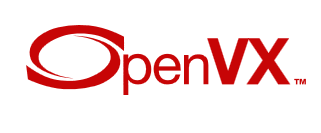Sponsored Post
 OpenVX is an API enabling software developers to add hardware accelerated computer vision capabilities to their programs. Coupled with the current upswing in the use of deep learning technologies, computer vision applications with OpenVX are becoming very important.
OpenVX is an API enabling software developers to add hardware accelerated computer vision capabilities to their programs. Coupled with the current upswing in the use of deep learning technologies, computer vision applications with OpenVX are becoming very important.
OpenVX is provided by The Khronos Group, a consortium of over 100 companies including that has been making royalty-free APIs since 2000. OpenVX is an open, royalty-free standard for cross platform acceleration of computer vision applications. It is designed to facilitate portable, optimized and power-efficient processing of methods for vision algorithms. This is aimed for embedded and real-time programs within computer vision and related scenarios. It uses a connected graph representation of operations.
OpenVX enables performance and power-optimized computer vision processing, especially important in embedded and real-time uses cases such as face, body and gesture tracking, smart video surveillance, advanced driver assistance systems (ADAS), object and scene reconstruction, augmented reality, visual inspection, robotics and more. OpenVX defines a higher level of abstraction for execution and memory models, enabling significant implementation innovation and efficient execution on a wide range of architectures while maintaining a consistent vision acceleration API for application portability.
[clickToTweet tweet=”OpenVX – The Standard for Computer Vision” quote=”OpenVX enables performance and power-optimized computer vision processing”]
OpenVX is an integral part of Intel Computer Vision SDK. This comprehensive toolkit is for developing and deploying vision-oriented solutions on platforms from Intel, including autonomous vehicles, digital surveillance cameras, robotics, and mixed-reality headsets. Based on OpenVX*, this SDK offers many useful extensions and supports heterogeneous execution across CPU and SoC accelerators using an advanced graph compiler, optimized and developer-created kernels, and design and analysis tools. It also includes deep-learning tools that unleash inference performance on deep-learning deployment.
When building your workload graphs, you can choose from a variety of optimized building blocks, including built-in OpenVX kernels and OpenCV functions. These kernels provide a wide range of ready-to-use functionality, including:
- Image processing
- Common computer vision routines
- Feature extraction and tracking
- Deep-learning inference
The Intel Computer Vision SDK is designed to make the heterogeneous capabilities of processors from Intel more accessible, thereby allowing developers to deliver the hardware’s full potential. Its OpenVX approach includes setting up function pipelines as directed acyclic graphs that allow additional optimization possibilities by fully describing the data flow through a set of algorithms. Approaches like automatic tiling are possible, which can allow multiple steps of an algorithm to work on the same local data without rewriting each function.

Download the free Intel® SDK for OpenCL™




Speak Your Mind